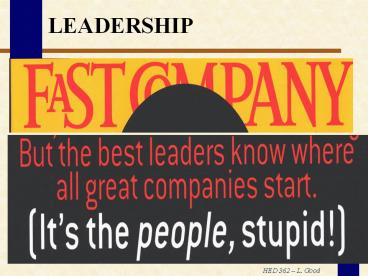LEADERSHIP PowerPoint PPT Presentation
1 / 20
Title: LEADERSHIP
1
LEADERSHIP
2
Why do we need leadership?
You dont need leadership to eat a warm cookie.
The only reason for leadership is to convince
people to do things that are either dangerous or
stupid. Generally speaking, wherever there is
leadership, theres lots of hollering and a few
warm cookies. Lets enjoy the lack of leadership
while we have it. Scott Adams Dont Step in
the Leadership
3
Leaders
- Think of the most effective leader you have known
- Traits
- Situation
- Think of the most ineffective leader you have
known - Traits
- Situation
4
LEADERSHIP - Theories
- Trait Theories
- 1920s 1950s
- Personal characteristics
- Intelligence, dominance, alertness
- Leaders born not made
- No cause and effect between leadership and traits
5
LEADERSHIP - Qualities
- Honesty
- Single most important ingredient is integrity
- Measured by observing behavior
- Forward Looking (Vision)
- Sense of direction
- Concern for future
6
LEADERSHIP - Qualities
- Inspiring
- Enthusiastic, energetic, positive
- Cheerleader
- Competent
- Capable and effective to lead toward goals
- Not a specialist in all areas but takes time to
learn - Value-added competence
7
LEADERSHIP - Qualities
- Fair-minded
- Supportive
- Broad-minded
- Intelligent
8
LEADERSHIP - Theories
- Behavioral Theories
- Late 1940s - 1950s
- Behavior vs. traits
- U of M studies
- Production centered
- Employee centered
- PC less effective actual performance
9
LEADERSHIP - Theories
- Ohio State studies
- Initiating structure
- Well defined job guidelines, channels of
communication - Consideration
- Emphasizes trust, respect, rapport, participatory
decision making
10
LEADERSHIP - Theories
- Ohio State studies findings
- Higher Initiating Structure yielded high
proficiency ratings but more employee grievances - Higher Consideration yielded lower proficiency
but lower absences
11
LEADERSHIP - Theories
- Contingency/Situational Theories
- Attention to the situation in which leaders
function - Trait and behavioral theories were inadequate
12
LEADERSHIP - Theories
- Fiedlers Contingency Model
- Group Performance contingent upon
- Motivational system of leader
- Task vs relationship
- Degree to which leader has power and influence in
a situation
13
LEADERSHIP - Theories
- 3 situational factors
- Leader-member relationship
- Trust, confidence, respect for leader
- Task structure
- Clarity of specific job
- Position power
- Inherent in leadership position
14
Case
- Individual has 8 subordinates who like him. He
structures the job by making work assignments and
by setting goals for required outputs. He is
also responsible for reviewing the work of
subordinates and is the main spokesperson for and
evaluator of the employees at merit review time.
15
Case
- Is leader member relationship good or poor?
- Good
- Is task-structure high or low?
- High
- Is position power strong or weak?
- Strong
16
LEADERSHIP - Types
- Transformational leaders Bezos, Gates
- Seek higher level needs- self-actualization
- Internal rewards big risks/big changes
- Vision- motivation for followers
- Charisma
- Inspirational motivation work for larger good
of organization
17
LEADERSHIP - Types
- Transactional leaders Clinton
- Exchange process rewards/benefits for
motivation/productivity - Contingent reward system- carrot/stick
- Smaller changes, lower risks
- MBO
- Autocratic
- Correct by negative feedback/discipline
18
Self-actualization
Transformational Leadership helps you aim here
Aesthetic
Knowledge/understanding
Self-esteem
Love/Belonging
Transactional Mgt. gives these
Safety
Basic Needs
19
Primary Differences between Transformational
Transactional Leadership
Categories Transactional Transformational
Leaders source of power Rank, position Character, competence
Follower reaction Compliance Commitment
Time frame Short term Long term
Rewards Pay, promotion, etc. Pride, self-esteem, etc.
Supervision Important Less important
Counseling focus Evaluation Development
Where change occurs Follower behavior Follower attitude, values
Where leadership found Leaders behavior Followers heart
20
LEADERSHIP - Types
- Servant Leaders (many unknown leaders)
- Leaders serve followers
- Listens well concerned with all
- Do not necessarily strive to be leaders

